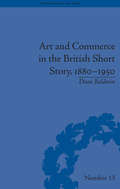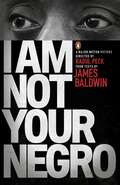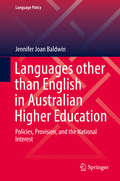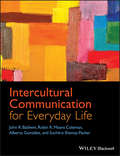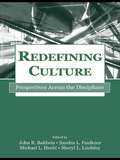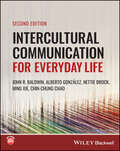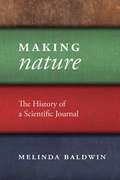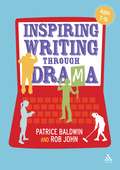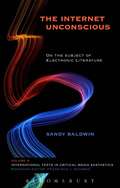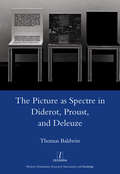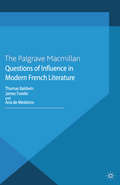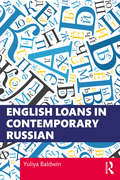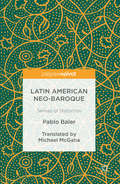- Table View
- List View
Art and Commerce in the British Short Story, 1880–1950 (The History of the Book)
by Dean BaldwinThe short story was a commercial phenomenon which took off in the late nineteenth century and lasted through to the rise of television and film. Baldwin uses a wide variety of sources to show how economic factors helped to dictate how and what a wide variety of authors wrote.
Art and Commerce in the British Short Story, 1880–1950 (The History of the Book #13)
by Dean BaldwinThe short story was a commercial phenomenon which took off in the late nineteenth century and lasted through to the rise of television and film. Baldwin uses a wide variety of sources to show how economic factors helped to dictate how and what a wide variety of authors wrote.
I Am Not Your Negro
by James Baldwin Raoul PeckThe New York Times bestseller based on the Oscar nominated documentary filmIn June 1979, the writer and civil rights activist James Baldwin embarked on a project to tell the story of America through the lives of three of his murdered friends: Medgar Evers, Malcolm X and Martin Luther King, Jr. He died before it could be completed. In his documentary film, I Am Not Your Negro, Raoul Peck imagines the book Baldwin never wrote, using his original words to create a radical, powerful and poetic work on race in the United States - then, and today. 'Thrilling . . . A portrait of one man's confrontation with a country that, murder by murder, as he once put it, "devastated my universe"' The New York Times'Baldwin's voice speaks even more powerfully today . . . the prose-poet of our injustice and inhumanity . . . The times have caught up with his scalding eloquence' Variety 'A cinematic séance . . . One of the best movies about the civil rights era ever made' Guardian 'I Am Not Your Negro turns James Baldwin into a prophet' Rolling Stone
Languages other than English in Australian Higher Education: Policies, Provision, and the National Interest (Language Policy #17)
by Jennifer Joan BaldwinThis book researches the study of languages other than English, and their place in the Australian tertiary sector. Languages are discussed in the context of the histories of Australian universities, and the series of reports and surveys about languages across the second half of the twentieth century. It demonstrates how changes in the ethnic mix of society are reflected in language offerings, and how policies on languages have changed as a result of societal influences. Also discussed is the extent to which influencing factors changed over time depending on social, cultural, political and economic contexts, and the extent to which governments prioritised the promotion and funding of languages because of their perceived contribution to the national interest.The book will give readers an understanding as to whether languages have mattered to Australia in a national and international sense and how Australia’s attention to languages has been reflected in its identity and its sense of place in the world.
Intercultural Communication for Everyday Life
by John R. Baldwin Robin R. Coleman Alberto González Suchitra Shenoy-PackerWritten for students studying intercultural communication for the first time, this textbook gives a thorough introduction to inter- and cross-cultural concepts with a focus on practical application and social action. Provides a thorough introduction to inter- and cross-cultural concepts for beginning students with a focus on practical application and social action Defines “communication” broadly using authors from a variety of sub disciplines and incorporating scientific, humanistic, and critical theory Constructs a complex version of culture using examples from around the world that represent a variety of differences, including age, sex, race, religion, and sexual orientation Promotes civic engagement with cues toward individual intercultural effectiveness and giving back to the community in socially relevant ways Weaves pedagogy throughout the text with student-centered examples, text boxes, applications, critical thinking questions, a glossary of key terms, and online resources for students and instructors Online resources for students and instructors available upon publication at www.wiley.com/go/baldwin
Intercultural Communication for Everyday Life
by John R. Baldwin Robin R. Coleman Alberto González Suchitra Shenoy-PackerWritten for students studying intercultural communication for the first time, this textbook gives a thorough introduction to inter- and cross-cultural concepts with a focus on practical application and social action. Provides a thorough introduction to inter- and cross-cultural concepts for beginning students with a focus on practical application and social action Defines “communication” broadly using authors from a variety of sub disciplines and incorporating scientific, humanistic, and critical theory Constructs a complex version of culture using examples from around the world that represent a variety of differences, including age, sex, race, religion, and sexual orientation Promotes civic engagement with cues toward individual intercultural effectiveness and giving back to the community in socially relevant ways Weaves pedagogy throughout the text with student-centered examples, text boxes, applications, critical thinking questions, a glossary of key terms, and online resources for students and instructors Online resources for students and instructors available upon publication at www.wiley.com/go/baldwin
Redefining Culture: Perspectives Across the Disciplines (Routledge Communication Series)
by John R. Baldwin Sandra L. Faulkner Michael L. Hecht Sheryl L. LindsleyRedefining Culture: Perspectives Across the Disciplines argues that culture is one of the most important factors we need to know when we interact as well as in our discussions of social problems and their solutions. This book picks up the dialogue where Kroeber and Kluckhohn left off in their classic 1952 collection and analysis of definitions of culture. As a resource for personal and academic libraries, this volume provides an updated listing of over 300 definitions of culture from a wide array of disciplines. Chapters examine how the definition of culture has changed historically, consider themes that cut across the definitions, and provide models for organizing approaches to defining culture. To round out this multi-disciplinary perspective, Renato Rosaldo provides a foreword, and prominent authors from six disciplines write about how they conceptualize culture and use it in their research and practice. This resource is an indispensable reference for scholars studying or integrating culture into their work. It will appeal to anyone interested in culture, particularly students and scholars in anthropology, intercultural and international communication, cultural studies, cultural and social psychology, linguistics, sociology, family studies, political science, intergroup relations, cultural geography, and multicultural education.
Redefining Culture: Perspectives Across the Disciplines (Routledge Communication Series)
by John R. Baldwin Sandra L. Faulkner Michael L. Hecht Sheryl L. LindsleyRedefining Culture: Perspectives Across the Disciplines argues that culture is one of the most important factors we need to know when we interact as well as in our discussions of social problems and their solutions. This book picks up the dialogue where Kroeber and Kluckhohn left off in their classic 1952 collection and analysis of definitions of culture. As a resource for personal and academic libraries, this volume provides an updated listing of over 300 definitions of culture from a wide array of disciplines. Chapters examine how the definition of culture has changed historically, consider themes that cut across the definitions, and provide models for organizing approaches to defining culture. To round out this multi-disciplinary perspective, Renato Rosaldo provides a foreword, and prominent authors from six disciplines write about how they conceptualize culture and use it in their research and practice. This resource is an indispensable reference for scholars studying or integrating culture into their work. It will appeal to anyone interested in culture, particularly students and scholars in anthropology, intercultural and international communication, cultural studies, cultural and social psychology, linguistics, sociology, family studies, political science, intergroup relations, cultural geography, and multicultural education.
Intercultural Communication for Everyday Life
by John R. Baldwin Alberto González Nettie Brock Ming Xie Chin-Chung ChaoINTERCULTURAL COMMUNICATION FOR EVERYDAY LIFE Face the global challenges of the future with this accessible introduction to communication across boundaries Communication between cultures can be challenging in a number of ways, but it also carries immense potential rewards. In an increasingly connected world, it has never been more important to communicate across a range of differences created by history and circumstance. Contributing to global communities and rising to meet crucial shared challenges—human rights disputes, refugee crises, the international climate crisis—depends, in the first instance, on a sound communicative foundation. Intercultural Communication for Everyday Life provides a thorough introduction to this vital subject for students encountering it for the first time. Built around a robust and multifaceted definition of culture, which goes far beyond simple delineation of national boundaries, it offers an understanding of its subject that transcends US-centricity. The result, updated to reflect dramatic ongoing changes to the interconnected world, is essential for students of cross—cultural communication and exchange. Readers of the second edition of Intercultural Communication for Everyday Life readers will also find: Accessible definitions of core concepts Revised and updated chapters reflecting the COVID-19 crisis, climate change challenges, and more An all-new chapter on social media as a tool for intercultural communication Intercultural Communication for Everyday Life is essential for students and other readers seeking a foundational overview of this subject.
Intercultural Communication for Everyday Life
by John R. Baldwin Alberto González Nettie Brock Ming Xie Chin-Chung ChaoINTERCULTURAL COMMUNICATION FOR EVERYDAY LIFE Face the global challenges of the future with this accessible introduction to communication across boundaries Communication between cultures can be challenging in a number of ways, but it also carries immense potential rewards. In an increasingly connected world, it has never been more important to communicate across a range of differences created by history and circumstance. Contributing to global communities and rising to meet crucial shared challenges—human rights disputes, refugee crises, the international climate crisis—depends, in the first instance, on a sound communicative foundation. Intercultural Communication for Everyday Life provides a thorough introduction to this vital subject for students encountering it for the first time. Built around a robust and multifaceted definition of culture, which goes far beyond simple delineation of national boundaries, it offers an understanding of its subject that transcends US-centricity. The result, updated to reflect dramatic ongoing changes to the interconnected world, is essential for students of cross—cultural communication and exchange. Readers of the second edition of Intercultural Communication for Everyday Life readers will also find: Accessible definitions of core concepts Revised and updated chapters reflecting the COVID-19 crisis, climate change challenges, and more An all-new chapter on social media as a tool for intercultural communication Intercultural Communication for Everyday Life is essential for students and other readers seeking a foundational overview of this subject.
Making "Nature": The History of a Scientific Journal
by Melinda BaldwinMaking "Nature" is the first book to chronicle the foundation and development of Nature, one of the world's most influential scientific institutions. Now nearing its hundred and fiftieth year of publication, Nature is the international benchmark for scientific publication. Its contributors include Charles Darwin, Ernest Rutherford, and Stephen Hawking, and it has published many of the most important discoveries in the history of science, including articles on the structure of DNA, the discovery of the neutron, the first cloning of a mammal, and the human genome. But how did Nature become such an essential institution? In Making "Nature," Melinda Baldwin charts the rich history of this extraordinary publication from its foundation in 1869 to current debates about online publishing and open access. This pioneering study not only tells Nature's story but also sheds light on much larger questions about the history of science publishing, changes in scientific communication, and shifting notions of "scientific community." Nature, as Baldwin demonstrates, helped define what science is and what it means to be a scientist.
Making "Nature": The History of a Scientific Journal
by Melinda BaldwinMaking "Nature" is the first book to chronicle the foundation and development of Nature, one of the world's most influential scientific institutions. Now nearing its hundred and fiftieth year of publication, Nature is the international benchmark for scientific publication. Its contributors include Charles Darwin, Ernest Rutherford, and Stephen Hawking, and it has published many of the most important discoveries in the history of science, including articles on the structure of DNA, the discovery of the neutron, the first cloning of a mammal, and the human genome. But how did Nature become such an essential institution? In Making "Nature," Melinda Baldwin charts the rich history of this extraordinary publication from its foundation in 1869 to current debates about online publishing and open access. This pioneering study not only tells Nature's story but also sheds light on much larger questions about the history of science publishing, changes in scientific communication, and shifting notions of "scientific community." Nature, as Baldwin demonstrates, helped define what science is and what it means to be a scientist.
Making "Nature": The History of a Scientific Journal
by Melinda BaldwinMaking "Nature" is the first book to chronicle the foundation and development of Nature, one of the world's most influential scientific institutions. Now nearing its hundred and fiftieth year of publication, Nature is the international benchmark for scientific publication. Its contributors include Charles Darwin, Ernest Rutherford, and Stephen Hawking, and it has published many of the most important discoveries in the history of science, including articles on the structure of DNA, the discovery of the neutron, the first cloning of a mammal, and the human genome. But how did Nature become such an essential institution? In Making "Nature," Melinda Baldwin charts the rich history of this extraordinary publication from its foundation in 1869 to current debates about online publishing and open access. This pioneering study not only tells Nature's story but also sheds light on much larger questions about the history of science publishing, changes in scientific communication, and shifting notions of "scientific community." Nature, as Baldwin demonstrates, helped define what science is and what it means to be a scientist.
Making "Nature": The History of a Scientific Journal
by Melinda BaldwinMaking "Nature" is the first book to chronicle the foundation and development of Nature, one of the world's most influential scientific institutions. Now nearing its hundred and fiftieth year of publication, Nature is the international benchmark for scientific publication. Its contributors include Charles Darwin, Ernest Rutherford, and Stephen Hawking, and it has published many of the most important discoveries in the history of science, including articles on the structure of DNA, the discovery of the neutron, the first cloning of a mammal, and the human genome. But how did Nature become such an essential institution? In Making "Nature," Melinda Baldwin charts the rich history of this extraordinary publication from its foundation in 1869 to current debates about online publishing and open access. This pioneering study not only tells Nature's story but also sheds light on much larger questions about the history of science publishing, changes in scientific communication, and shifting notions of "scientific community." Nature, as Baldwin demonstrates, helped define what science is and what it means to be a scientist.
Inspiring Writing through Drama: Creative Approaches to Teaching Ages 7-16
by Patrice Baldwin Rob JohnInspiring Writing through Drama offers interactive, high-quality drama schemes that will motivate andinspire students aged 7-16 to write for a range of purposes and audiences. Each drama unit offers: • A planning grid flagging the writingopportunities within the drama• Original resources, such as poems, text messagesand fragments of graffiti• Individual, group and whole-class writingopportunities, some teacher-led and others guided by the students• Icons to signpost differentiated activities Reading, writing, speaking and listeningopportunities are embedded within the drama experiences, and you can follow theschemes or use the texts as a springboard to developing your own drama unitsand writing opportunities. The authors offer guidance on using drama strategiesimaginatively and encourage you to assess the impact on the writing outcomes ofyour students. This book offers a clear methodology and high-quality practicaldrama activities that will motivate students to write purposefully withincompelling imaginary contexts.
Inspiring Writing through Drama: Creative Approaches to Teaching Ages 7-16
by Patrice Baldwin Rob JohnInspiring Writing through Drama offers interactive, high-quality drama schemes that will motivate andinspire students aged 7-16 to write for a range of purposes and audiences. Each drama unit offers: • A planning grid flagging the writingopportunities within the drama• Original resources, such as poems, text messagesand fragments of graffiti• Individual, group and whole-class writingopportunities, some teacher-led and others guided by the students• Icons to signpost differentiated activities Reading, writing, speaking and listeningopportunities are embedded within the drama experiences, and you can follow theschemes or use the texts as a springboard to developing your own drama unitsand writing opportunities. The authors offer guidance on using drama strategiesimaginatively and encourage you to assess the impact on the writing outcomes ofyour students. This book offers a clear methodology and high-quality practicaldrama activities that will motivate students to write purposefully withincompelling imaginary contexts.
The Internet Unconscious: On the Subject of Electronic Literature (International Texts in Critical Media Aesthetics)
by Sandy BaldwinWinner of the N. Katherine Hayles Award for Criticism of Electronic Literature from the Electronic Literature OrganizationThere is electronic literature that consists of works, and the authors and communities and practices around such works. This is not a book about that electronic literature. It is not a book that charts histories or genres of this emerging field, not a book setting out methods of reading and understanding. The Internet Unconscious is a book on the poetics of net writing, or more precisely on the subject of writing the net. By 'writing the net', Sandy Baldwin proposes three ways of analysis: 1) an understanding of the net as a loosely linked collocation of inscriptions, of writing practices and materials ranging from fundamental TCP/IP protocols to CAPTCHA and Facebook; 2) as a discursive field that codifies and organizes these practices and materials into text (and into textual practices of reading, archiving, etc.), and into an aesthetic institution of 'electronic literature'; and 3) as a project engaged by a subject, a commitment of the writers' body to the work of the net. The Internet Unconscious describes the poetics of the net's "becoming-literary,†? by employing concepts that are both technically-specific and poetically-charged, providing a coherent and persuasive theory. The incorporation and projection of sites and technical protocols produces an uncanny displacement of the writer's body onto diverse part objects, and in turn to an intense and real inhabitation of the net through writing. The fundamental poetic situation of net writing is the phenomenology of "as-if.†? Net writing involves construal of the world through the imaginary.
The Internet Unconscious: On the Subject of Electronic Literature (International Texts in Critical Media Aesthetics)
by Sandy BaldwinWinner of the N. Katherine Hayles Award for Criticism of Electronic Literature from the Electronic Literature OrganizationThere is electronic literature that consists of works, and the authors and communities and practices around such works. This is not a book about that electronic literature. It is not a book that charts histories or genres of this emerging field, not a book setting out methods of reading and understanding. The Internet Unconscious is a book on the poetics of net writing, or more precisely on the subject of writing the net. By 'writing the net', Sandy Baldwin proposes three ways of analysis: 1) an understanding of the net as a loosely linked collocation of inscriptions, of writing practices and materials ranging from fundamental TCP/IP protocols to CAPTCHA and Facebook; 2) as a discursive field that codifies and organizes these practices and materials into text (and into textual practices of reading, archiving, etc.), and into an aesthetic institution of 'electronic literature'; and 3) as a project engaged by a subject, a commitment of the writers' body to the work of the net. The Internet Unconscious describes the poetics of the net's “becoming-literary,” by employing concepts that are both technically-specific and poetically-charged, providing a coherent and persuasive theory. The incorporation and projection of sites and technical protocols produces an uncanny displacement of the writer's body onto diverse part objects, and in turn to an intense and real inhabitation of the net through writing. The fundamental poetic situation of net writing is the phenomenology of “as-if.” Net writing involves construal of the world through the imaginary.
Picture as Spectre in Diderot, Proust, and Deleuze
by Thomas Baldwin"The possibility of ekphrasis, the verbal representation of visual imagery, is fundamental to all writing about art, be it art criticism, theory or a passage in a novel. But there is no consensus concerning how such representation works. Some take it for granted that writing about art can result in a precise match between words and visual images. For others, ekphrasis amounts to a kind of virtuoso rivalry, in which the writer aims to outdo the pictorial image that is being described. In close readings of Diderot, Proust and Deleuze, Thomas Baldwin shows how ekphrasis can create a spectral effect. In other words, ekphrastic spectres do not function as fully present stand-ins for given works of art; nor can they be reduced to the status of passive and absent others. Baldwin also explores the ways in which the works of Diderot, Proust and Deleuze inhabit each other as ghostly influences."
Picture as Spectre in Diderot, Proust, and Deleuze
by Thomas Baldwin"The possibility of ekphrasis, the verbal representation of visual imagery, is fundamental to all writing about art, be it art criticism, theory or a passage in a novel. But there is no consensus concerning how such representation works. Some take it for granted that writing about art can result in a precise match between words and visual images. For others, ekphrasis amounts to a kind of virtuoso rivalry, in which the writer aims to outdo the pictorial image that is being described. In close readings of Diderot, Proust and Deleuze, Thomas Baldwin shows how ekphrasis can create a spectral effect. In other words, ekphrastic spectres do not function as fully present stand-ins for given works of art; nor can they be reduced to the status of passive and absent others. Baldwin also explores the ways in which the works of Diderot, Proust and Deleuze inhabit each other as ghostly influences."
Roland Barthes: The Proust Variations (Contemporary French and Francophone Cultures #62)
by Thomas BaldwinThis book confronts the singularity of the relationship between two exemplary writers of the last century in order to challenge and to reinvigorate our notions of what art and criticism – literary or otherwise – can do. While it takes Roland Barthes’s encounters with Marcel Proust’s monumental masterpiece À la recherche du temps perdu as its specific focus, the implications of its argument are far-reaching. Indeed, the book argues that Barthes’s writing on Proust’s work between the early 1950s and 1980 (including a substantial set of unpublished notes for a series of seminars delivered at the University of Rabat in 1969–1970) proposes not only a critical culture of Proust that is productively inconsistent, but also, more generally, a fresh understanding of criticism as a creative activity that embraces insecurity and variation as it refuses to remain fixed upon reassuringly stable themes, meanings and interpretations.
Questions of Influence in Modern French Literature (Palgrave Studies in Modern European Literature)
by Thomas Baldwin James Fowler Ana De MedeirosThis collection engages with questions of influence, a vexed and problematic concept whose intellectual history is both ancient and vast. It examines a range of texts written in French, sometimes in dialogue with visual/musical works, drawn mainly from the eighteenth century onwards. Connections are made with related work in a range of disciplines.
English Loans in Contemporary Russian
by Yuliya BaldwinEnglish Loans in Contemporary Russian presents over 2,000 English borrowings in the Russian lexicon, providing a unique account of changes in the language and culture. The entries in this practical Russian-English dictionary cover a wide range of well-established loanwords to more recent neologisms. They address an increasingly relevant part of the contemporary Russian lexicon, particularly in the language of business, politics, mass media, computer, medicine, and other professional areas. The dictionary reflects how the language is responding to new patterns of life and will be of interest to Russian language learners and linguists.
English Loans in Contemporary Russian
by Yuliya BaldwinEnglish Loans in Contemporary Russian presents over 2,000 English borrowings in the Russian lexicon, providing a unique account of changes in the language and culture. The entries in this practical Russian-English dictionary cover a wide range of well-established loanwords to more recent neologisms. They address an increasingly relevant part of the contemporary Russian lexicon, particularly in the language of business, politics, mass media, computer, medicine, and other professional areas. The dictionary reflects how the language is responding to new patterns of life and will be of interest to Russian language learners and linguists.
Latin American Neo-Baroque: Senses of Distortion
by Pablo BalerPablo Baler studies the ruptures and continuities linking the de-centered dynamics of the 17thcentury to the logic of instability that permeates 20th century visual and literary production in Latin America. Bringing philosophy, literary interpretation, art criticism, and a poetic approach to the history of ideas, Baler offers a new perspective from which to understand the uncanny phenomenon of baroque distortion. This interdisciplinary inquiry not only leads to a more specific formulation regarding the singularity of the reappropriations of the baroque in Spanish America, but also allows for a more comprehensive assessment of its historical reach in the broader context of the representational crisis of modernity.
